Wild Mustang GT still around, eager to be tamed
By John Gilbert
Back about 1970, the Trans-American series, or Trans-Am, was a premier road-racing series, for the suddenly popular “ponycars” like Mustang, Camaro, Challenger, Barracuda, Firebird and later the AMC Javelin.
Mark Donohue in the Roger Penske Camaro was hard to beat, but the most colorful team was the Bud Moore Mustangs led by the inimitable Parnelli Jones. Driving the No. 15 Mustang painted a uniquely bright yellow-orange, Jones won the 1970 championship and always ran up front, referring to his own race car as being “school-bus orange.” Even though it was more yellow-orange, the nickname was as good as the fact.
While the other ponycars disappeared in a changing society gravitating toward larger and smaller cars, the Mustang ensued, coming out in various shapes and sizes, some of which now seem odd in retrospect, as Ford has recreated the Mustang in the image of those 1970-era cars. So has Dodge, with Challenger, and Chevrolet, with Camaro.
They are all captivating, in a future-retro sort of a way, but to me, the Mustang is the most refined, maybe even near perfect for recapturing that era.
A few months ago, Ford announced that it may eliminate production of nearly all its cars in favor of the newly popular and various SUVs. People throughout the country and industry were shocked, and Ford followed by announcing the only cars it would keep producing were the Mustang and the Focus. No more Taurus or Fusion, or Fiesta, which seems startling.
But as long as the the Mustang continues, all is OK.
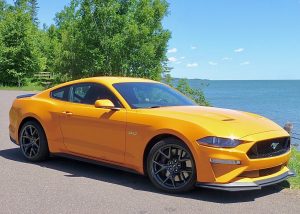
Familiar look, rock-firm platform, and 460-horsepower V8 with a 6-speed stick is Mustang GT identification.
I’ve driven some model of every Mustang ever made, and I owned a 1970 Boss 302 for over 20 years, which I believe was the best road-racing-ready production car ever. It had gone through various modifications and alterations before I sold it to a guy who wanted to restore it to original form. Among the reasons I relinquished it was because the newest generation Mustangs had become so high-tech they could compete, in my mind, with all that was great about the Boss 302.
Right after the Fourth of July, a new 2018 Ford Mustang GT arrived inmy driveway in
Duluth, Minnesota, and it showed upfor me to live with for a week. It practically glowed in an amazing metallic yellow-orange that immediately struck me as a close proximity to “school-bus orange.”
It was thoroughly enjoyable to drive, if not to ride in as a passenger. My wife, Joan, put up with it for about 5 miles of Duluth-area, obstacle-course passenger-seat riding before she announced she was less than anxious to ride in it any more — Recaro bucket seats or not.
The finely-tuned suspension has toggle-switch dash settings to adjust from normal to sport, to track, to dragstrip, to special competition, and each alteration goes from firm to firmer, and the steering stiffens noticeably. As a driver, you love it; as a passenger, it gets pretty tiresome.

Bike-riding cousins relived Duluth college days by revisiting Hwy. 61 and cruised by for a closer look along the North Shore.
The thrill that conquers all such nitpicks, however, is the unbelievable sound that goes right from your shoe soles to your body’s soul in about one-tenth of a second. It is a spine-tingling rumble, reverberating through the neighborhood. Not really that obtrusive to your neighbors, but absolute music to your ears.
Climb in, adjust the seat, and the steering wheel, put the clutch to the floor and hit the starter button. Give it a second to let that great sound engulf you and the interior of the car, and blip the throttle a couple times if it’s not up to your standards.
Let out the clutch, gently, and try to do it smoothly enough to launch without a neck-snapping jerk or two. The big, wide rear tires grip like race tires — on dry pavement, at least — and they stick with precision in the tightest cornering, while the hyper-tuned suspension holds the car’s attitude in place.
Again, though, we go back to that engine, a 5.0-liter V8 which smoothes out from raw to low-rev power to a smoother roar as the RPMs built. Shift the slick 6-speed stick into second, then third, and you have swiftly attained any legal speed limit on any road in the country. With three gears to go.
The 5.0-liter V8 has been tweaked and refined to deliver 460 horsepower and 420 foot-pounds of torque, perfectly regulated with that 6-speed and judicioius throttle control.
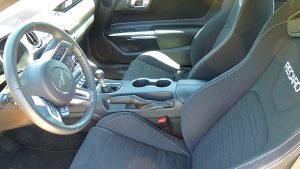
Recaro bucket seats, toggle-switch controls, racing steering wheel, and high-tech connectivity fill the Mustang GT interior.
There are still even more potent Mustang models available for more money, with superchargers and all, but the GT stands out as a true bargain in the industry, with a base GT price of $35,190. Of course, you can start adding on satellite radio, navigation and all kinds of options, and run the price easily over $40,000, but the base car is well-equipped as is.
The neat and efficient interior of the test car had all the latest electronic-gizmo features of the contemporary car world, and that includes the taught suspension-tire combination and the quick steering. It also adds traction control, and a much appreciated hill-start feature that isn’t new in the industry anymore, but is great on a steep incline when you have to make sure of your touch on the clutch as you launch. The car sits motionless as you release the clutch, a welcome aid.
I found the width of the front tires was such that you need to pay extra attention on tight turns because the width and grip almost cause the car to jerk free of your hold on the wheel, as if it wants to steer itself. Like a wild horse of its own name, it wants to take the bit in its mouth. So be ready to manhandle the steering wheel just a bit to maintain your authority.
While the driving is an exciting venture at any and all speeds, and in any and every gear, the sound, and the almost-glow-in-the-dark color make the Mustang GT a cinch attention-grabber, for passers-by, pedestrians, and, yes, officers of the law.
The front end of the Mustang GT has a ferocious look to it, with the spoiler hanging down so low you’ll also want to be extra careful how close you get to parking lot divider curbs. The large mouth of the grille is impressive, especially when flanked by the slick, and sleek, LED headlights and their enclosure.
The silhouette is pure Mustang, and not the blocky 1966 original, but the sleek fastback of the 1969 and 70 road-racing Mustangs. It looks aerodynamically slippery, and you are surprised that there is something close to adequate rear-seat headroom under the steeply sloping roof. Even more surprising is the trunk, which opens to a large-capacity cavern that will house a lot of stuff when you hit the road. And hitting the road will be a temptation you will find difficult to resist with the Mustang GT.
Ford engineers have done great work with their engines in recent years, from the EcoBoost V6 and 4s which can mimic larger engines with their turbocharged efficiency. But they have not overlooked the 5.0 V8, obvioiusly. This engine is the mainstay of the F150 pickup line, unless you go for the EcoBoost, but it feels as it belongs to the Mustang.
With all the new, high-tech vehicles coming out, in sedans, compacts, SUVs and pickup trucks, there is so much to evaluate and test that I must admit I was not desperate to get my hands on the new, 2018 Mustang, even though I knew it had been redone with revised styling, and that the old and tired standard V6 had been dropped.
Once it showed up, with its charcoal-grey spokey wheels on the low-profile tires, and that stunning paint job — which shows off its millions of metallic grains only when you get close and check it in bright sunlight — only then did I realize how glad I was that I had been chosen to spend a week with the new Mustang GT.
Then I started the engine, blipped the throttle, and considered what might happen if I headed deeper into the North woods just to see how long it would take Ford to find me.


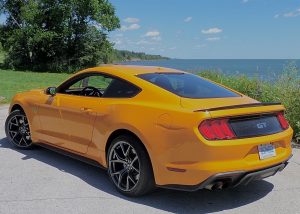
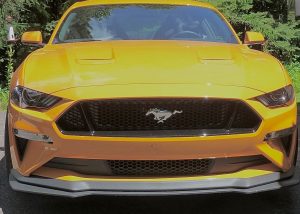
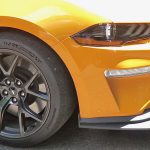

 John Gilbert is a lifetime Minnesotan and career journalist, specializing in cars and sports during and since spending 30 years at the Minneapolis Tribune, now the Star Tribune. More recently, he has continued translating the high-tech world of autos and sharing his passionate insights as a freelance writer/photographer/broadcaster. A member of the prestigious North American Car and Truck of the Year jury since 1993. John can be heard Monday-Friday from 9-11am on 610 KDAL(www.kdal610.com) on the "John Gilbert Show," and writes a column in the Duluth Reader.
John Gilbert is a lifetime Minnesotan and career journalist, specializing in cars and sports during and since spending 30 years at the Minneapolis Tribune, now the Star Tribune. More recently, he has continued translating the high-tech world of autos and sharing his passionate insights as a freelance writer/photographer/broadcaster. A member of the prestigious North American Car and Truck of the Year jury since 1993. John can be heard Monday-Friday from 9-11am on 610 KDAL(www.kdal610.com) on the "John Gilbert Show," and writes a column in the Duluth Reader.